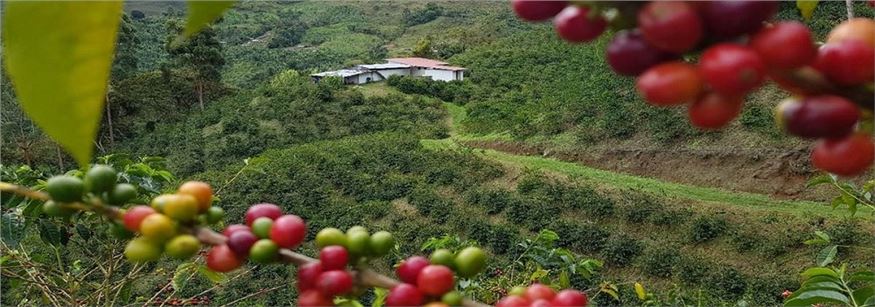Colombia Origin Update

Our Colombian trip paints an optimistic outlook towards the future of Colombian coffee.
Finally, after a near 30-hour journey, entering through El Dorado just as the sun breached the horizon, we reached Bogota, Colombia, perched upon the Eastern Cordillera at 2,640 metres above sea level. Already, we knew there was much to traverse in a whirlwind two-week expedition.
Our travels took us from high-end, experimentally-processed Geishas at Cerro Azul, to Cenicafe’s latest varietal creation, to the indigenous Nasa people of CENCOIC Co-operative, to the self-sufficient, mountain farms of Bilbao - we experienced a vast cross-section of Colombia’s coffee offering quite comprehensively.

Picker at Finca Potosi. The most experimental farm of Café Granja La Esperanza’s five farms. Where trials on cross pollination and hybridization are in full effect.
Visiting Rigoberto Herrera’s Café Granja La Esperanza operation in the Western Andes range outside of Tulua, we were privy to some very cool discoveries pertaining to tree manipulation.
At the Cerro Azul farm the agronomists have been able to almost double the fruit yield on their trees comparable to trees of the same age and variety, under the same conditions, through increasing plant density or by using a simple and efficient method of ‘splitting’ main stem of the sapling, resulting in two tree trunks.

This Geisha tree will yield more fruit while not taking up more area on the farm. Cerro Azul, Café Granja La Esperanza.
Further to this, taking place at Finca Potosi, was an array of new experimental cross-pollination trials. The resulting trees (and therefore the fruit) will vastly vary depending on which ‘father’ and ‘mother’ were utilized in the pollination process. This proactive and strategic experimentation being undertaken aims to manipulate the desired results. These can include increased cup score, yield, disease resistance, screen size and so on, which are carefully factored into the varietal selection.

Workers’ station in the distance at Cerro Azul farm.
Our journey next had us spend a few days with FNC (Colombian Coffee Growers’ Federation). Whilst visiting farms with their Extension Team, we learned that while the rust-resistant Castillo varietal has yielded good results for some years now, new kid on the block, ‘Cenicafe-Uno’ is the latest coffee variety created by the innovation team at Cenicafe.
Talking with producer Aureliano (who was one of the first recipients of this variety just two years ago) at his farm Finca El Descanso, in the Chinchina municipality we were told this varietal was produced to grow slower, without decreasing yield, with the hopes that the tree will remain at a more easily harvestable height for two years longer (on average) than its counterparts. As future-proofing is also an important part of this innovation project, ‘Cenicafe-Uno’ has also been designed to be resistant to a host of African borne disease which are yet to hit Colombia’s shores.

Pulping Cenicafe–Uno at La Finca El Descanso.
Self-sufficiency seemed to be an aspiration shared by most producers and Co-operatives, and the most impressive set-up was to be found another twelve hours drive south of Chinchina, in Bilbao.
Juan Andres owns and operates Finca El Encanto. His family are members of the ASOTBILBAO Co-operative along with another 44 other coffee producing families, and his farm is one of the most strikingly beautiful, ecological farms we had the privilege of visiting. The family and workers farm avocadoes, goats, cows, chickens, pigs, coriander and many different fruit trees for subsistence.
The farmhouse itself is supplied with naturally-produced methane gas via the use of a bio-digester, which is fed with a mix of household and animal waste. We even lunched upon a delicious suckling pig cooked with the gas!

All 45 members of ASOTBILBAO turned up to spend the afternoon with us and invited us to join their member meeting. Premiums from Fairtrade and organic certifications have assisted greatly and are relied upon. For example, a recent landslide had wiped out one members’ farmhouse and blocked transport in and out. The Co-operative was able to efficiently provide resources and to clear and rebuild.
Despite the technical advancements and beautiful mountain farms, there are some nation-wide issues and potentially problematic circumstances, reiterated by producers and Co-operative members across the country, to which the solutions are unclear. What is clear however, is that some of these issues will require a large scale, collaborative effort to combat.
Nation-wide, Colombia is experiencing a shortage of pickers – from Popayan to Bilbao and across the Andes to Tulua, this conundrum is a doozy! We heard this narrative told on numerous occasions – during peak harvest, labour is becoming increasingly scarce. To be clear, the pickers job is not an easy one. Simply traversing the steep mountains (which a lot of the country’s coffee is grown on), is a tough task, in of itself. Exacerbating this issue, an ever-increasing external demand and internal-industry desire for higher cup scores, forcing the need for an acute, attentiveness to detail during the picking process.
Some specialty farms are paying substantially higher wages in exchange for the highly selective hand harvesting, a solution which is not feasible for regional and commercial coffee producers where margins are much slimmer. We did witness a real and tangible, concerted effort, especially within Co-operative communities, to re-invest in the youth in an attempt to instil a desire to stay in the coffee life (or to enter it). However, with the next generation, by and large, looking for the city life and tertiary education, its concerning who will continue the farming tradition.
To make matters worse, unprecedented weather patterns over the past decade have made predicting annual cycles difficult. Some growing regions are reporting shade trees; where once necessary to control the optimal six hours of sunlight for a healthy coffee tree, are being cut down to maximise sun exposure. Contrastingly in other locations, shade trees are being planted where they were previously not required. Data collection by the FNC has recorded average sunlight hours has dropped in some locations to just 5.8 hours, and is overall still on the decline.
Despite the evident trials and tribulations, with all things being considered, our 2019 Colombian Origin trip paints an optimistic outlook towards the future of Colombian coffee. Adaptability and perseverance are strengths that will be required, but thankfully, Colombia possesses them in spades and is well practiced in utilising them!
Happy Roasting,
The Bennetts Team


